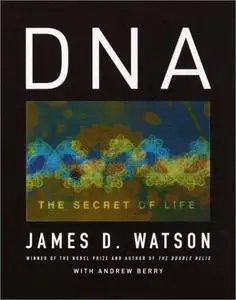James D. Watson and Andrew Berry, «DNA: The Secret of Life»
Knopf | ISBN 0375415467 | 1st edition (April 1, 2003) | PDF | 7,84 Mb | 464 Pages
DOWNLOAD LINKS:
http://rapidshare.de/files/31040550/DNA-Secret.of.Life_0375415467.zip
OR
http://mihd.net/1.706/DNA-Secret.of.Life_0375415467.zip.html
What makes DNA different from hordes of competitors purporting to help readers understand genetics is that it is written by none other than James Watson, of Watson and Crick fame. He and his co-author Andrew Berry have produced a clear and easygoing history of genetics, from Mendel through genome sequencing. Watson offers readers a sense of immediacy, a behind-the scenes familiarity with some of the most exciting developments in modern science. He gleefully reports on the research juggernaut that led to current obsessions with genetic engineering and cloning. Aided by profuse illustrations and photos, Watson offers an enthusiastic account of how scientists figured out how DNA codes for the creation of proteins–the so-called "central dogma" of genetics. But as patents and corporations enter the picture, Watson reveals his concern about the incursions of business into the hallowed halls of science.
After 1975, DNA was no longer solely the concern of academics trying to understand the molecular underpinnings of life. The molecule moved beyond the cloisters of white-coated scientists into a very different world populated largely by men in silk ties and sharp suits.
In later chapters, Watson aims barbs at those who are concerned by genetic tinkering, calling them "alarmists" who don't understand how the experiments work. It is in these arguments that Watson may lose favor with those whose notions of science were born after Silent Spring. Nevertheless, DNA encompasses both sides of the political issues involved in genetics, and Watson is an enthusiastic proponent of debate on the subject. The book accompanies a 5-part PBS series. –Therese Littleton
From Publishers Weekly:
Who better than James Watson to lead a guided tour of DNA? When he and his English colleague, Francis Crick, discovered the double helix structure of the DNA molecule in 1953, little could they imagine that a mere 50 years later scientists would be putting the finishing touches on a map of the human genome. In this magisterial work, Watson, who won the Nobel Prize with Crick for their discovery, guides readers through the startling and rapid advances in genetic technology and what these advances will mean for our lives. Watson covers all aspects of the genome, from the layout of four simple bases on the DNA molecule through their complex construction into genes, then to the mechanisms whereby proteins produced by genes create our uniquely human characteristics-as well as the genetic mutations that can cause illnesses or inherited diseases like Duchenne muscular dystrophy and Huntington's disease. Watson may have mellowed a little over the years since he displayed his youthful brashness in The Double Helix, but he still isn't shy about taking on controversial subjects. He criticizes biotech corporations for patenting genes, making diagnostic medical procedures horribly expensive and damping further basic research. He notes that while China and other countries with large populations to feed have eagerly grasped the potential of genetically modified foodstuffs, America squandered $100 million on a recall of taco shells and the genetically modified corn used in them. He pleads passionately for the refinement and widespread use of prenatal genetic testing. Watson will probably provoke the most controversy with his criticism of scientists, corporations and government funding sources for their avoidance of important areas of research-notably the genetics of skin coloration-for political reasons. Every reader who wants to understand their own medical future will want to read this book. 100 color and b&w illus.
Inside Flap Copy:
Fifty years ago, James D. Watson, then just twentyfour, helped launch the greatest ongoing scientific quest of our time. Now, with unique authority and sweeping vision, he gives us the first full account of the genetic revolution?from Mendel?s garden to the double helix to the sequencing of the human genome and beyond.
Watson?s lively, panoramic narrative begins with the fanciful speculations of the ancients as to why ?like begets like? before skipping ahead to 1866, when an Austrian monk named Gregor Mendel first deduced the basic laws of inheritance. But genetics as we recognize it today?with its capacity, both thrilling and sobering, to manipulate the very essence of living things?came into being only with the rise of molecular investigations culminating in the breakthrough discovery of the structure of DNA, for which Watson shared a Nobel prize in 1962. In the DNA molecule?s graceful curves was the key to a whole new science.
Having shown that the secret of life is chemical, modern genetics has set mankind off on a journey unimaginable just a few decades ago. Watson provides the general reader with clear explanations of molecular processes and emerging technologies. He shows us how DNA continues to alter our understanding of human origins, and of our identities as groups and as individuals. And with the insight of one who has remained close to every advance in research since the double helix, he reveals how genetics has unleashed a wealth of possibilities to alter the human condition?from genetically modified foods to genetically modified babies?and transformed itself from a domain of pure research into one of big business as well. It is a sometimes topsy-turvy world full of great minds and great egos, driven by ambitions to improve the human condition as well as to improve investment portfolios, a world vividly captured in these pages.
Facing a future of choices and social and ethical implications of which we dare not remain uninformed, we could have no better guide than James Watson, who leads us with the same bravura storytelling that made The Double Helix one of the most successful books on science ever published. Infused with a scientist?s awe at nature?s marvels and a humanist?s profound sympathies, DNA is destined to become the classic telling of the defining scientific saga of our age.



